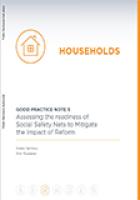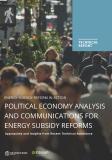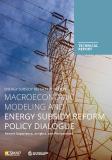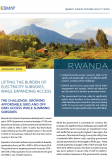Publications
This note provides guidance to policy makers who are looking to utilize Social Safety Nets (SSNs) to mitigate the welfare impacts of energy subsidy reforms (ESRs) on the poor. The good practice note explains (a) why SSNs are an effective tool in the context of ESR, and (b) different options for rapid scale-up or implementation of SSNs. It introduces a three-stage analytical approach that includes (a) assessing the welfare losses caused by ESR; (b) taking stock of existing SSN and near-SSNs, and modeling expansion options; and (c) assessing the readiness of the existing or planned SSNs for providing protection against the negative consequences of the price shock.
The scope of this good practice note is confined to cases where ESRs lead to higher prices paid by energy consumers. As good practice note one outlines, ESRs do not necessarily lead to higher prices, and could even decrease prices paid, such as when producer subsidies in the form of price support paid for by consumers are eliminated, or when consumer price subsidies lead to illegal diversion and out-smuggling, acute fuel shortages, and prices that are even higher than official prices on the black markets. The latter is particularly important: consumers may be paying much higher prices before the reform, having to develop coping mechanisms to deal with energy shortages. ESRs may improve the quality of energy delivery service, reducing energy shortages and thereby improving the welfare of energy consumers. In this context, the note has been prepared for social protection specialists and government officials responsible for social sectors portfolio. It provides an overview and guidance on the use of tools, principles, methods, and practices, in the analysis of social protection issues relevant to ESR. The note has a narrow focus, specifically looking at SSNs as measures that can support the poor during times of ESR.
ESRAF Good Practice Overview: Guidance for Comprehensive Energy Subsidy Reforms
ESRAF Good Practice Note 1: Identifying and Quantifying Energy Subsidies
ESRAF Good Practice Note 2: Assessing the Fiscal Cost of Subsidies and Fiscal Impact of Reform
ESRAF Good Practice Note 6 to come: Identifying the Impacts of Higher Energy Prices on Firms and Industrial Competitiveness
ESRAF Good Practice Note 7: Modeling Macroeconomic Impacts and Global Externalities
ESRAF Good Practice Note 10: Designing Communication Campaigns for Energy Subsidy Reform
Yemtsov, Ruslan; Moubarak, Amr. 2018. Assessing the Readiness of Social Safety Nets to Mitigate the Impact of Reform: Energy Subsidy Reform Assessment Framework (ESRAF) Good Practice Note 5. ESMAP Paper. Washington, D.C.: World Bank Group.




